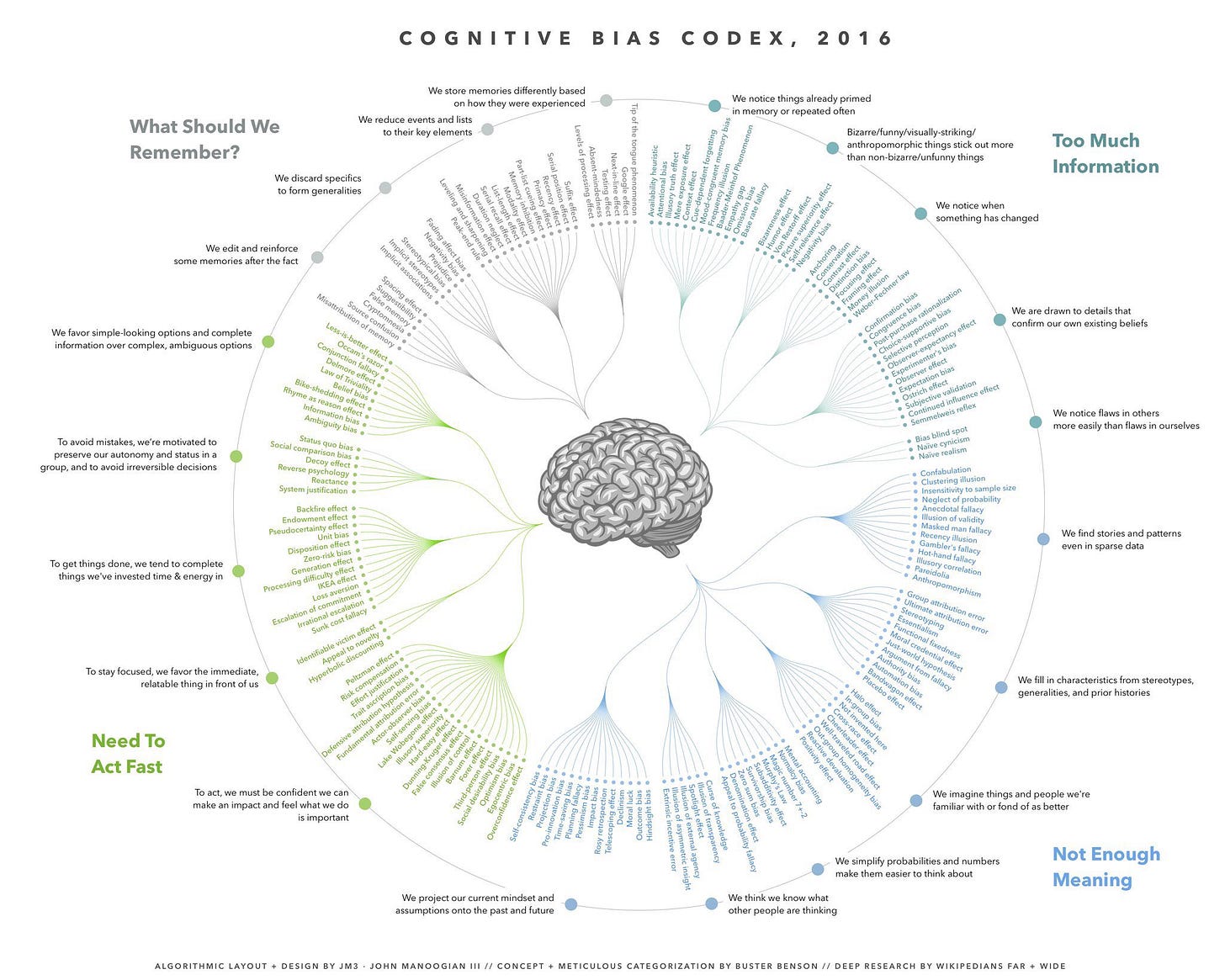One Bias to Rule Them All
All cognitive biases = one of a handful of fundamental beliefs + confirmation bias

Hi all,
I’m in New Zealand at the moment for a brief holiday and to scatter my father’s ashes (he died last November). For that reason, I won’t be publishing anything new this weekend. Instead, I’m republishing one of my early posts: one that first went out before most of you came on board.
I hope you enjoy it. I’ll be back with new content next week.
-Steve
I can explain it only by a weakness of the scholarly mind that I have often observed in myself. I call it theory-induced blindness: once you have accepted a theory and used it as a tool in your thinking, it is extraordinarily difficult to notice its flaws.
-Daniel Kahneman (1934-2024)
Psychologists have posited hundreds of cognitive biases over the years, from hindsight bias to ingroup-outgroup bias to the fundamental attribution error. They’ve even proposed a bias bias: a tendency to overestimate the impact of cognitive biases on (other) people’s thinking. Inventing and cataloging biases seems to be one of psychologists’ favorite pastimes.
But a fascinating recent paper by Aileen Oeberst and Roland Imhoff argues that all our cognitive biases boil down to one of a handful of fundamental beliefs, coupled with just one “ultimate” bias. The fundamental beliefs include such ideas as “I make correct assessments” and “I am good.” And the ultimate bias is confirmation bias: the tendency to seek and favor information consistent with one’s preexisting views.
In this post, I’ll look at a range of common cognitive biases, and the six fundamental beliefs that give rise to them.
Too Many Biases, Not Enough Time
The starting point for Oeberst and Imhoff’s paper is the observation that cognitive biases are growing and multiplying at an ever-increasing rate. Every psychologist and their uncle has come up with one. To give you a sense of the scale of the problem, the following infographic summarizes 50 of the best-known cognitive biases.
It’s quite a list - and it’s only the tip of the iceberg. Here’s another infographic, this one covering more than 180 biases. Warning: If you actually try to read it, you might never get to the end of this post…
Bringing Order to the Chaos
It’s too much! The uncontrolled proliferation of cognitive biases has led to general confusion, a dangerous increase in infographics, and a scientific literature that might be described as “kind of a mess.”
It’s into this morass that Oeberst and Imhoff have boldly waded with their new paper, in a bid to save psychologists from themselves. The pair have proposed a novel theory that aims to cut back the thicket of cognitive biases, and get to the true core of the phenomenon. The paper provides only a rough sketch of the theory - but it’s a fascinating sketch, and I suspect that they might be onto something.
The basic idea, as mentioned, is that all cognitive biases derive from a simple two-part recipe. The recipe is: Take one of a handful of fundamental beliefs and combine it with belief-consistent information processing, also known as confirmation bias. All else follows from that.
Six Fundamental Beliefs that Bias Our View of the World
To see how the theory works, let’s look more closely at the six fundamental beliefs proposed by Oeberst and Imhoff, and the cognitive biases they might give rise to. Note that the fundamental beliefs are probably best thought of as implicit assumptions, rather than conscious beliefs in the traditional sense.
1. “My experience is a reasonable reference.”
The first fundamental belief is the unspoken idea that “my experience is a reasonable reference.” As Oeberst and Imhoff argue, many cognitive biases plausibly stem from a tendency to take our current subjective experience as the yardstick for our judgments about everything else. In doing this, we naturally project our own experience onto other people. Depending on the focus of our experience, this can spawn various well-known cognitive biases, which are then supported and protected by belief-consistent information processing.
The Spotlight Effect (the tendency to overestimate the extent to which others are noticing us)
We’re often very aware of what we’re doing and how we might appear to others. We therefore assume that other people are likewise very aware of what we’re doing and how we appear. This is particularly common among people with social anxiety. Often, though, the inference is mistaken. As the writer David Foster Wallace noted, “You’ll worry less about what people think about you when you realize how seldom they do.”



